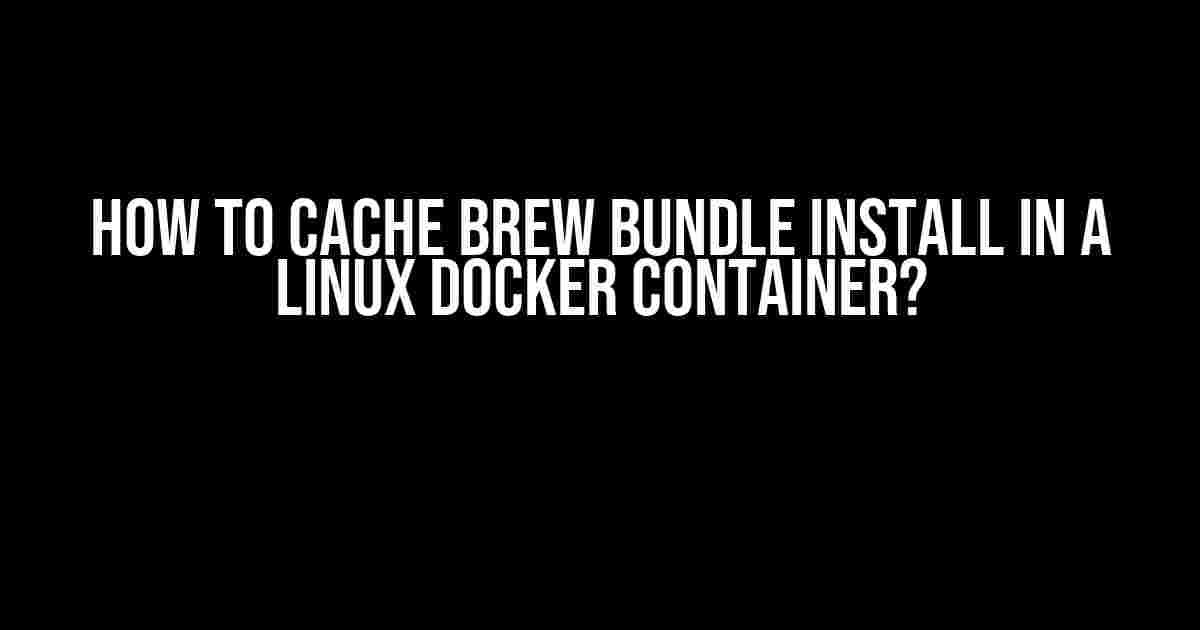Are you tired of waiting for your Docker container to build every time you make a change to your Brewfile? Do you want to speed up your development process and make your builds more efficient? Look no further! In this article, we’ll show you how to cache Brew bundle install in a Linux Docker container, so you can get back to coding faster.
What is Brew Bundle?
Brew Bundle is a package manager for macOS and Linux that allows you to easily install and manage dependencies for your projects. It’s similar to npm or pip, but for macOS and Linux packages. With Brew Bundle, you can specify dependencies in a Brewfile, and then run `brew bundle install` to install all the required packages.
Why Cache Brew Bundle Install?
When you run `brew bundle install` in a Docker container, it can take a while to complete, especially if you have a large number of dependencies. This is because Brew Bundle has to download and install each package from scratch every time you run the command. By caching the install, you can skip this step and reuse the installed packages from previous builds, saving you time and increasing your productivity.
Step 1: Create a Dockerfile
To cache Brew Bundle install, you’ll need to create a Dockerfile that installs Brew and caches the bundle install. Here’s an example Dockerfile to get you started:
FROM ubuntu:latest
RUN apt-get update && apt-get install -y build-essential && rm -rf /var/lib/apt/lists/*
RUN /bin/bash -c "$(curl -fsSL https://raw.githubusercontent.com/Homebrew/install/HEAD/install.sh)"
ENV BREW_PREFIX=/home/brew
ENV PATH=$BREW_PREFIX/bin:$PATH
RUN brew install bundler
WORKDIR /app
COPY Brewfile .
RUN brew bundle install --cache
Step 2: Create a Brewfile
Next, you’ll need to create a Brewfile that specifies the dependencies for your project. Here’s an example Brewfile:
tap homebrew/bundle
brew "git"
brew "ruby"
brew "node"
Step 3: Build the Docker Image
With your Dockerfile and Brewfile in place, you can now build the Docker image:
docker build -t myapp .
Step 4: Run the Docker Container
Once the image is built, you can run the Docker container:
docker run -it myapp
How Caching Works
When you run `brew bundle install –cache` in your Dockerfile, Brew Bundle installs the dependencies and caches the results. The next time you build the Docker image, Brew Bundle will use the cached results instead of reinstalling the dependencies from scratch. This can save you a significant amount of time, especially if you have a large number of dependencies.
Tips and Variations
Here are some additional tips and variations to help you get the most out of caching Brew Bundle install:
- Use a Volume for the Cache: By default, the cache is stored in the Docker container’s filesystem. If you want to persist the cache across builds, you can use a volume to store the cache. For example:
docker run -it -v $(pwd)/.cache:/app/.cache myappThis will store the cache in a `.cache` directory in your current working directory.
- Specify a Cache Duration: You can specify a cache duration using the `–cache` option. For example:
brew bundle install --cache=1hThis will cache the install for 1 hour. If the cache is older than 1 hour, Brew Bundle will reinstall the dependencies.
- Use a Cache Server: If you’re working in a team or have multiple machines, you can use a cache server to share the cache across machines. For example, you can use a Redis server as a cache server:
brew bundle install --cache=redis://localhost:6379This will store the cache in a Redis server on localhost:6379.
Conclusion
Caching Brew Bundle install in a Linux Docker container is a simple yet effective way to speed up your development process. By following the steps outlined in this article, you can reduce the time it takes to build your Docker image and get back to coding faster. Remember to experiment with different caching options and variations to find the solution that works best for your project.
| Cache Option | Description |
|---|---|
| –cache | Cache the install and reuse the results on subsequent builds. |
| –cache=1h | Cache the install for 1 hour. Reinstall dependencies if the cache is older than 1 hour. |
| –cache=redis://localhost:6379 | Use a Redis server on localhost:6379 as a cache server. |
By caching Brew Bundle install, you can take your Docker builds to the next level and focus on what matters most – coding!
- Brew Official Website
- Brew Bundle Documentation
- Docker Build Command
Frequently Asked Question
Getting stuck with caching brew bundle install in a Linux Docker container? Don’t worry, we’ve got you covered!
What is the purpose of caching brew bundle install in a Linux Docker container?
Caching brew bundle install in a Linux Docker container helps to speed up the build process by reusing the installed dependencies, reducing the time spent on installing dependencies from scratch.
How do I cache brew bundle install in a Linux Docker container?
You can cache brew bundle install by adding the `–cache` flag to the `brew bundle install` command in your Dockerfile, like this: `RUN brew bundle install –cache`. This will store the installed dependencies in the cache, allowing them to be reused in subsequent builds.
Where is the cache stored in a Linux Docker container?
The cache is stored in the `/root/.cache/brew` directory by default. You can specify a different cache directory by setting the `HOMEBREW_CACHE` environment variable in your Dockerfile.
How do I invalidate the cache in a Linux Docker container?
You can invalidate the cache by deleting the `/root/.cache/brew` directory or by running the `brew bundle install` command with the `–no-cache` flag. This will force brew to reinstall the dependencies from scratch.
Can I cache brew bundle install across multiple Docker builds?
Yes, you can cache brew bundle install across multiple Docker builds by using a persistent volume or a Docker volume to store the cache. This allows you to reuse the cache between builds, even if the Docker container is restarted or rebuilt.
